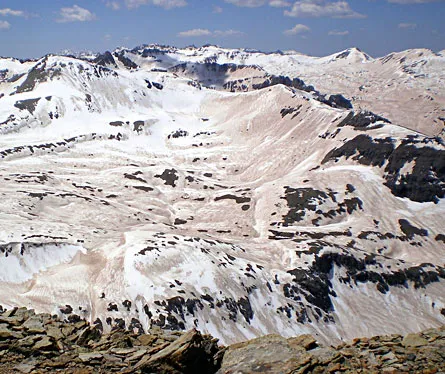Kicking up more dust in deserts may bring unnaturally synchronized spring greening to mountain peaks.

Livestock grazing, mining and other human activities in dry lands churn up extra dust that winter storms sweep away and dump on distant alpine slopes along with snow, explains Heidi Steltzer of Colorado State University in Fort Collins. Darkening the snow speeds up the spring melt of the snowpack, but Steltzer and her colleagues now find that it won’t speed up the first sprouts of spring. Premature bald spots instead stay wintry until certain signs of spring pass a threshold, the researchers report online June 29 in Proceedings of the National Academy of Sciences. Once temperatures lose their sting, these delayed plants suddenly burst forth together.
Typically, snow doesn’t melt before average temperatures rise above freezing. Then variation in snow depth creates patchy melting, and spring green gradually spreads across the slopes. But a dirty-snow world could create more bare patches of ground before temperatures warm, which could ultimately mean more synchronous greening of alpine slopes.
That possible shift could reverberate through species interactions, resource availability and other aspects of life on snowy peaks, Steltzer predicts. Nutrients could wash off the peaks before plants are ready to use them. And a big burst of blooming means more plants competing for pollinators and nutrients at one time. Wildlife could also have to cope with food plants that are available in one rush instead of staggered over time.
To explore the effects of dust build-up on snow, Steltzer and her colleagues forced snow to melt early on patches of northeast- and southeast-facing slopes above the tree line at Red Mountain Pass in Colorado’s San Juan Mountains. Typically several winter storms each year drop dust from the Colorado Plateau onto these slopes, and researchers mimicked the effect in May 2008 by adding black fabric or a heavy dusting of ground-up, local rock to snowpacks that were one to two meters deep.
Darker surfaces absorb more energy than lighter ones, and snow darkened with dust melted 7 days earlier on average than untreated snow.
All that snow melting is a dramatic event at high altitudes. “I think of snowmelt as like flushing the toilet—a lot of water going down all at once,” Steltzer says.
In areas where researchers did nothing to the natural snowpack (which did include some dust from winter storms), the first little green leaves poked out of the soil some five to eight days after the snow melted. But in areas where researchers rushed the melting, the plants took 15 to 20 days to green up after snow was gone. Once conditions had passed environmental thresholds, researchers again saw a quick response to melting snow.
“The threshold response idea makes sense to me,” says David Inouye of the University of Maryland in College Park. He reports what looks like a similar lag effect after early snowmelt in his long-term observations of the timing of plant blooming at the Rocky Mountain Biological Laboratory. “Not all plants show that kind of threshold effect, so the proposed synchronization may not be as complete as the PNAS paper suggests,” he says.
Dust build-up is becoming more of an issue as people expand their activities in dry lands, she says. A recent sediment study found that European settling of the American West has already quintupled the dust burden in mountain snow.






